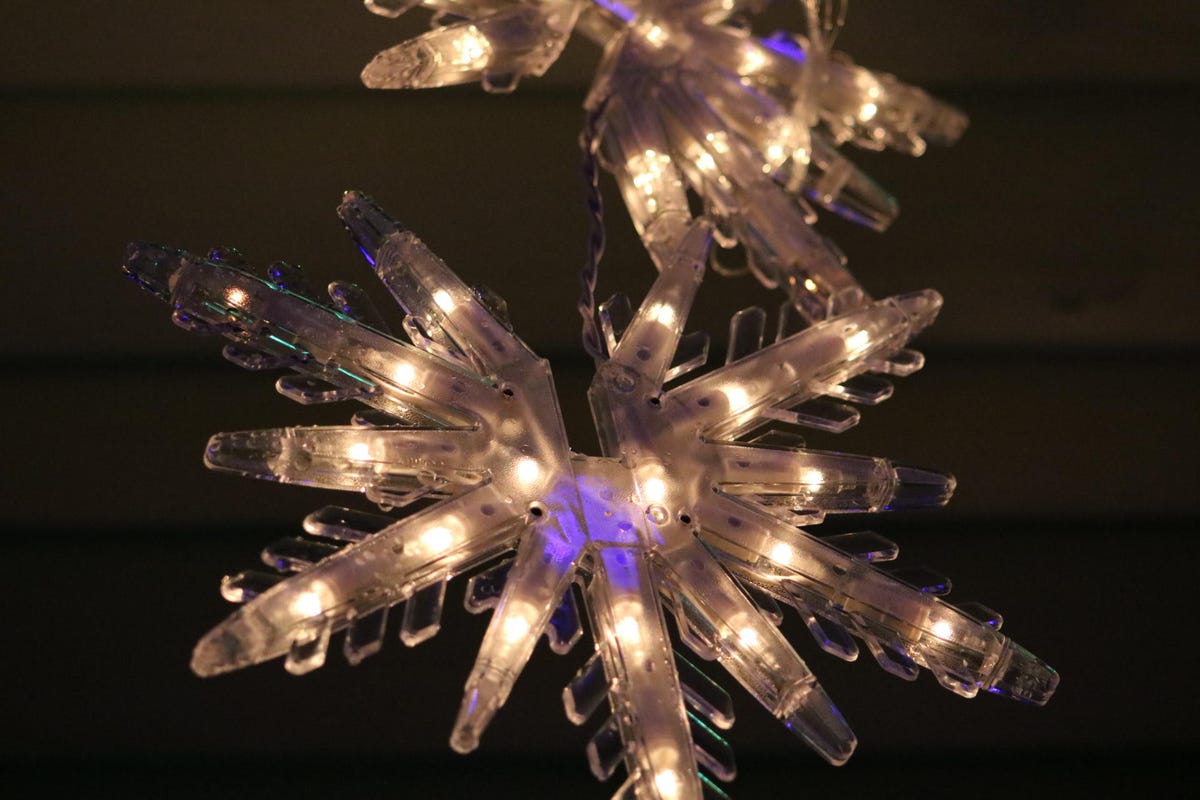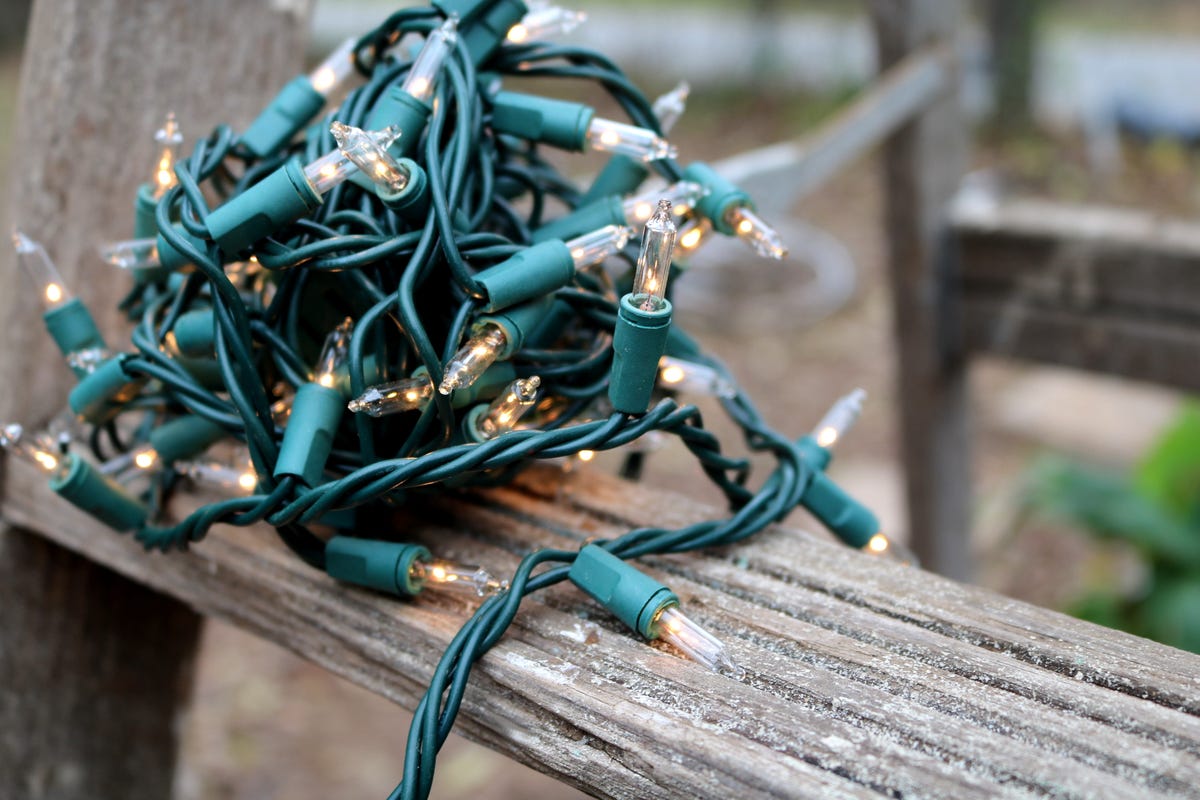Christmas Light Safety Guide: 16 Tips to Avoid a Decorations Disaster
Christmas lights can pose a serious hazard inside and outside your home. Here's how to prevent fire and other potential problems.

The only thing that'll get you in the holiday spirit faster than egg nog are Christmas lights. White lights, bright lights, colorful strings and twinklers; it doesn't matter the type of light, no seasonal display is complete without them.
These pretty decorations don't come without risks, though. Falls, electrocution and even fires are real possibilities. (Looking at you, the dad from every '80s and '90s movie.) An average of 770 fires are caused by Christmas lights every year, according to a 2020 report by the National Fire Protection Association.
With proper preparation and safety practices, you can avoid dangerous situations with your holiday decor.
Here are 16 potential holiday light hazards and safety tips to avoid Christmas light sparks, blowouts, fires and other scary scenarios.
1. Beware missing or broken bulbs
Replace any missing or broken bulbs before you string up your porch or tree because they could lead to electrocution, fires or injuries.
Most lights come with replacement bulbs, but you can also buy a pack at your local home improvement store for about $3.
2. Fix busted string lights
It happens. You found a broken light string. Luckily, CNET has a full guide to fixing Christmas lights, including fixing bulbs and changing out fuses.

3. Use the right ladder
If you decide to pull a Clark Griswold and decorate your home's exterior and roof, you'll need a ladder to reach those high-up spots.
The type of ladder you use matters. Metal ladders conduct electricity, which can lead to electrical shocks. The Electrical Safety Foundation International recommends using a wooden or fiberglass ladder when hanging lights to avoid electrical shocks.
4. Pick the right kind of light
While indoor and outdoor lights are similar in appearance and function, you shouldn't use them interchangeably. Indoor lights should only be used indoors and outdoor lights should only be used outside. Here's why.
Indoor lights have been specifically tested to make sure they aren't a fire hazard for tree decorating, while outdoor lights are specifically tested to withstand cold and rainy weather. Outside lights could pose a fire hazard if you string them up on the family tree because they're often hotter, while the indoor lights probably wouldn't survive the snow storm.
To be safe, you can purchase lights that are certified for indoor and outdoor usage. Whether you're using indoor or outdoor, though, the US Fire Administration recommends buying only lights certified by an approved testing facility (more on this next).
5. Look for the UL seal
No matter the climate where you live, look for the UL seal on the box.
That seal means that the lights meet the national industry standards of the American National Standards Institute.
6. Choose the right cord
Like the string lights, you should always only use an extension cord that is rated for outdoor use when stringing up lights on the porch or house. Indoor-use extension cords aren't made to withstand cold or wet environments.
7. Keep the cord dry
You shouldn't let your extension cords sit on the ground as shown in the photo. Make sure the junction where your light cord and your extension cord meet stay out of puddles, damp soil, snow or ice because a potentially damaged extension cable could cause injury or death from electrocution, fire, or carbon monoxide poisoning if wet.
You can buy an inexpensive cord protector -- like the Twist and Seal Heavy Duty Cord Protector -- to keep your cords dry and safe. You could also plan your light display so that connections are suspended off the ground instead of sitting in contact with it.
8. Prevent tripping hazards
Keep your light strands off the ground, too. Lights and cords on the ground pose a tripping hazard and can easily be broken if stepped on.
If you want to make a cool runway effect down your walkway, use light stakes. You just stick them in the ground and the lights clip to the top of the stake.
You can also use anchoring pins or ground staples to secure extension cords to the ground on either side of a walkway to prevent tripping hazards. Simply thread the cord through the middle and push the ends of the pin or staple into the dirt. If you have some wire hangers, a pair of pliers and wire cutters lying around, you can make your own staples in a pinch. Just cut 8 inches (20 centimeters) of wire and bend it into a U-shape.
9. Don't make your lights a year-long attraction
Sure, they're pretty, but don't leave your lights up for too long. Many lights, including smart lights, aren't meant for long-term use. Be sure to check the light's box for information on just how long you can safely leave your lights up.
10. Mind the outlet
If your lights look like this photo, then you're doing it wrong -- that's way too many plugs in one outlet.
We recommend plugging your lights into a ground fault circuit interrupter (GFCI) outlet. These outlets will shut the circuit down if there is too much current flowing through, preventing fires.
If your outlet is a GFCI, it will have a reset and test button in the center. If you don't have one, you can purchase a portable GFCI outlet from your home improvement store. You could try this waterproof in-line GFCI or this portable GFCI.
11. Keep it to 3 strands
The Electrical Safety Foundation International recommends connecting no more than three strings of incandescent lights together. If you're using LEDs, most UL-labeled lights will tell you on the package how many strings of lights you can safely string together.
12. Don't put cords through doors and windows
Don't run your extension cords through window or door cracks. The cord could become pinched, which can fray the insulation around the wires and lead to a nasty shock.
13. Never use staples, tacks or nails to hang lights
Sharp objects can easily pierce the strands and create a potential electrical shock. It's best to use plastic holders or simply wrap the lights around the fence, porch or tree.
14. Turn off lights overnight
Though beautiful and festive, you should turn off your lights for a few hours each day.
15. Be careful decorating living creatures
Never string up a human or animal with the lights that you plug in, even if it's just for a photo -- they could get an electric shock or burns if the lights are too hot.
Most places that sell Christmas lights also sell strands of battery-powered lights. These don't get hot and won't potentially electrocute the wearer. Plus, they come in fun shapes. We've seen strands shaped like snowflakes, candy canes and gumdrops.
16. Light your car safely
When decorating your vehicle for Christmas parades, make sure to use a power inverter to produce enough power for lights that have a voltage more than 12V.
Most Christmas lights are 110V AC (alternating-current) and your vehicle can typically only power 12V DC (direct current). The Potek 2,000W Power Inverter Three or the Ampeak 1,200W Power Inverter are good choices.
Also, be sure to firmly secure the lights to your vehicle so that they don't drag on the ground and shatter. Strong magnets that you can buy from craft stores work well. Just be sure not to drag the magnet across your car's finish when pulling it off. Always pull up to avoid scratches.
Don't forget to only use your car holiday lights when it's dry outside, too. 110V AC lights can give you a deadly shock if they get wet.



